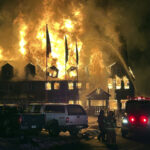A study of the Oso landslide in Washington state that killed 43 people in March says the amount of water that saturated a hillside made it especially destructive when it gave way.
The soil lost its coherence and flowed like a liquid in a process called liquefaction.
The Daily Herald reported the study was published last week by U. S. Geological Survey hydrologist Richard Iverson who is based at the Cascades Volcano Observatory in Vancouver.
The slide occurred on a dry day during one of the wettest winters on record in the area.
Topics Washington
Was this article valuable?
Here are more articles you may enjoy.


 Baldwin Group to Buy CAC Group for About $1B in Cash and Stock
Baldwin Group to Buy CAC Group for About $1B in Cash and Stock  Owner of Historic Minnesota Resort Charged With Arson, Insurance Fraud
Owner of Historic Minnesota Resort Charged With Arson, Insurance Fraud  Acrisure CEO Greg Williams Makes $400M Commitment to Michigan State University
Acrisure CEO Greg Williams Makes $400M Commitment to Michigan State University  Chubb, The Hartford, Liberty and Travelers Team Up on Surety Tech Launch
Chubb, The Hartford, Liberty and Travelers Team Up on Surety Tech Launch 

